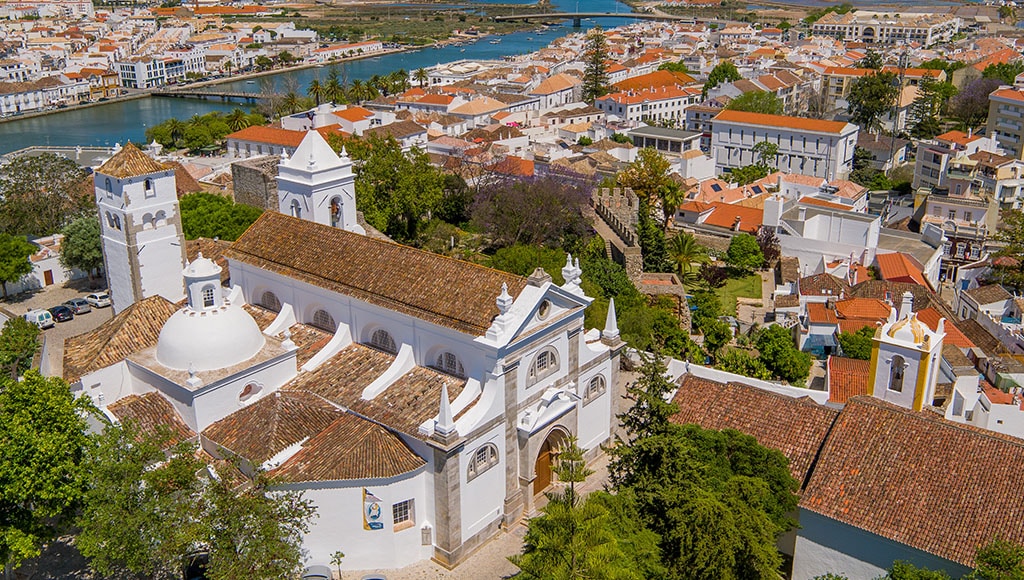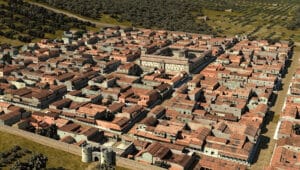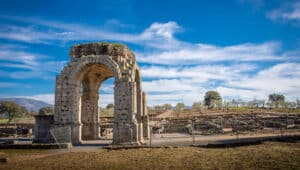When the Christian forces first conquered Tavira in 1242, they quickly transformed the town centre Friday mosque into the Parish Church (Igreja Matriz) of Santa Maria do Castelo.
The foundation of the church of Santiago followed soon after, in any case before 1270, and it too became a Parish Church, even though it is within a few metres only of Santa Maria. Some say that this church is also based on a previous mosque. To dissociate these buildings from their Moslem past, both churches were re-oriented so that their high altars face to the north.
Every Tavira-born person belongs to one or the other parish and would be baptised in one or the other church and there are naturally only two fonts in the town.
Most of the boundary between the two parishes is formed by the River Séqua/Gilão: the parish of Santiago lies to the south/west of the river, and that of Stª Maria on the north/east. As Stª Maria itself is to the south/west of the river, a certain space around it was added to its parish.
The line delimiting that space begins at the river at the foot of Calçada D. Ana, goes up the hill until it meets Travessa de Stª Maria, runs along a line between the two churches, then northwards to join Calçada de D. Paio Pires Correia; turning eastwards in front of the Misericórdia Church, down the steps of the Calçada da Galeria, over the Praça da República, along Rua Alexandre Herculano, Rua Guilherme Gomes Fernandes, and continuing down Travessa da Caridade right down to the sea.
Those properties whose main entrance lies on one of the streets mentioned all belong to the parish of Stª Maria, and so too all those properties which lie between that line and the river.
The remaining parish churches in other parts of Tavira county were not established until the 16th century or later. We have no exact dates, but the style of these churches is similar to that of the Misericórdia Church, which was constructed between 1541-1551.
Those parishes are Cachopo, Conceição, Luz de Tavira, Santa Catarina da Fonte do Bispo and Santo Estêvão. Two other parishes have recently been established, Cabanas and Santa Luzia. In a recent national reorganisation, the civil functions of many of the country’s civil parishes (freguesias) were amalgamated, while their liturgical functions and parish churches (paróquias) remain separate. 
Private Chapels and Brotherhoods
In addition to the two parish churches in the town of Tavira, a wide range of churches served different brotherhoods (confrarias or irmandades). The history of Tavira is replete with brotherhoods, many of which had their own chapels, such as São Sebastião, São Roque and São Lázaro. Other brotherhoods were established in the existing churches.
To name only a few and their home locations: Confraria de São Crispim e São Crispiano(Brotherhood of St Crispin and St Crispinian, extinct in 1893) inIgreja Matriz de Santa Maria;Confraria de Nossa Senhora do Desterro (Brotherhood of Our Lady of Exile, extinct by 1899) in Igreja Matriz de Santiago; Confraria de Nossa Senhora da Luz (Brotherhood of Our Lady of Light, flourished 1775-1905) in Igreja da Ordem Terceira de São Francisco.
These brotherhoods used to hold religious processions in the town, and the images they carried in their processions were kept for the remainder of the year in their particular chapels. As most of the brotherhoods have ceased to exist, and their chapels have been deconsecrated, their religious artefacts have usually been taken in by another church. An example is Nosso Senhor dos Passos, which used to belong to Capela de São João Baptista, and whose statuary is now situated in the eponymous side chapel in Stª Maria.
There were so many brotherhoods that the sources say that it would be boring to name them all. They were formed by men of similar interests; for example, the seamen at São Lázaro(also known as Nossa Senhora do Livramento), or the soldiers at São Roque. The Brotherhood of St Crispin and St Crispinian was that of the New Christian leather tanners and shoemakers; these people were of Moorish descent, and after 1500, it seems that they voluntarily adopted the Christian religion. Their retable, now renamed, still exists in Stª Maria. And as each brotherhood had its own patron with its own saint’s day, there were religious processions on many days of the year.
It is difficult today to appreciate the central part in town life of the brotherhoods. If we can imagine a life of no television, no radio, no sport, no newspapers, no cars, trains or aeroplanes, it would become obvious that people had to make their own culture and in their own hometowns.
In a society which was greatly religious, it is not surprising that people turned to the church to occupy their spare time, and the brotherhoods were in many ways similar to clubs, where like-minded people could come together.
In the whole of Portugal, there were thousands of local brotherhoods, and their public expression was in their processions. Just as today we see fierce competitive rivalries between the fans of different sports teams, so in the days of religious processions, there were jealousies and rivalries between the supporters of the different brotherhoods. A famous fado about Lisbon has the following lines: [Lisbon] follows devotedly in religious processions … [Lisbon] has her jealousies and passions. 
The Religious Foundations
During the 500 years 1312-1834, 25 mosteiros and conventos werefounded in the Algarve. The English use shows that a monastery is for men and a convent is for women, but the Portuguese use is different, since these words do not describe the sex of the occupants. A mosteiro is a closed order, where the members remain secluded from public gaze for their lifetime; a convento is used by an open order, where the members are supposed to mix with the general public both to collect alms and to evangelise; these orders are often referred to as mendicant orders.
There was a plan to establish a Jesuit house in Tavira, but the Jesuits founded only two houses in the Algarve – the first in Faro in 1605 (the Colégio de Santiago Maior, now the Teatro Lethes) and the second in Portimão in 1660 (the Colégio de São Francisco Xavier, or Colégio dos Jesuítas). Their plan for Tavira was never realised.
Of the 25 Algarvian foundations, no fewer than six were in Tavira. One was a mosteiro, a foundation for women, and the other five were male conventos. These five were suppressed in 1834, and the women’s mosteiro was allowed to remain open until its last sister died in 1862, on condition that it admitted no novices. At the time they were built, those houses built in Tavira were at the edges of the habitation areas of the town.
The six religious houses in the town were, in order of foundation, together with their Order:
- Convento de São Francisco, 1312-1834 (Franciscan friars)
- Mosteiro de Nossa Senhora da Piedade, 1509-1862 (Cistercian nuns)
- Convento de Nossa Senhora da Graça, 1542-1834 (Augustine hermits)
- Convento de São Paulo, 1606-1834 (Hermits of St Paul)
- Convento de Santo António, 1612-1834 (Hooded friars of piety)
- Convento de Nossa Senhora do Carmo, 1745-1834 (Barefoot Carmelites)
The Third Orders
Two of the churches in Tavira are owned by Third Orders. For the non-religious person, this term may require some explanation. First Order in the Catholic Church generally denotes the male religious, both monks and friars: the major orders include Carmelites, Benedictines, Franciscans, Dominicans and Augustinians; Second Orderdenotes female religious or nuns; they may be Dominicans, Franciscans or Poor Clares.
Members of the First and Second Orders take vows of poverty, chastity and obedience.
Members of Third Orders, also known as tertiaries, are usually lay men and women who do not make similar religious vows, but participate in the good works of their Order, and lead a Christian life.
They may be allowed to wear some elements of the Order’s habit such as the scapular, which looks like a tabard, and is worn over the main habit or cassock. Both the ceiling painting and the high altar retable in Igreja da Ordem Terceira de Nossa Senhora do Carmo show Our Lady bestowing the scapular on St Simon Stock.
A valuable source of income to each of these two Third Orders used to be the charge for interment in one of the two cemeteries in Tavira – that behind the Igreja da Ordem Terceira de São Francisco, and that behind the Igreja da Ordem Terceira de Nossa Senhora do Carmo.
In 1846, the government passed a law forbidding burials inside churches, and Tavira Câmara bought land next to the church of São Francisco to create a public graveyard.
In 1918, the Câmara opened the municipal cemetery beyond the railway station at São Pedro, and the Third Orders were forbidden to accept any further burials and so lost a major source of income. The Third Orders now maintain themselves by means of individual annual subscriptions.
























